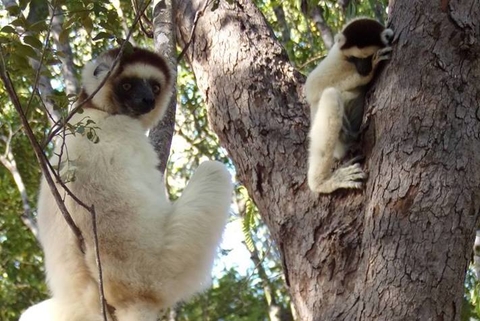New study sheds light on early human hair evolution
Study of wild population of lemurs helps researchers assess the impacts of climate, body size and color vision on the evolution of primate hair
Among primates, including humans, hair is an important feature of diversity and evolution, serving functions tied to thermoregulation, protection, camouflage and signaling. However, the evolution of wild primate hair has remained relatively understudied until recently.

Now, University of Massachusetts evolutionary anthropologist Jason Kamilar and researchers from the Primate Genomics Lab at the George Washington University have examined what factors drive hair variation in a family of wild lemur populations known as Indriidae.
In a new study published in the American Journal of Biological Anthropology, the researchers specifically aimed to assess the impacts of climate, body size and color vision on hair evolution.
They found:
- Sifaka lemurs, which are native to Madagascar, have denser head hair in dry, open environments. The researchers believe that, like early humans, the lemurs’ hair helps protect against the strong rays of the sun.
- Lemurs in colder regions are more likely to have dark hair. This is the first evidence in mammals for a classic pattern in nature called Bogert’s Rule, which states that dark colors could aid with thermoregulation as they help absorb heat from the sun’s rays.
- Red hair in lemurs is associated with enhanced color vision. According to the researchers, populations that can see a larger range of colors are more likely to have patches of red hair.
- Multiple evolutionary pressures may act on one trait and the strength of their influence may vary between species.

“The reduced body hair that modern humans exhibit is unique among primates,” says Kamilar, an associate professor of anthropology at UMass Amherst. “Unfortunately, hair does not fossilize, so studying how human hair has evolved through time is very challenging, although we can study our primate relatives to give us insight into our deep-time ancestors.”
Brenda Bradley, an associate professor of anthropology who directs GW’s Primate Genomics Lab and is a co-author on the study, explains that our understanding of hair evolution and diversity in other primates helps us fill in the gaps of our own human evolutionary story.
“Most people are intrigued by the diversity of hair on their own bodies, and the variety of hair types among people around the world,” Bradley said. “Understanding hair patterns in non-human primates, such as these lemurs, may provide a comparative context for understanding how variation arose in human hair.”
“We examined lemurs in Madagascar that live in a variety of habitats, but consistently exhibit an upright posture similar to human ancestors, and found that lemurs living in hot, dry environments had higher hair follicle density on the top of their head,” Kamilar says. “This may be related to greater UV exposure for this part of their body, which has been a hypothesis proposed to explain the presence of high human head hair density.”
The researchers note future work should focus on samples across smaller geographic or phylogenetic (family-level, genus-level) scales and from diverse non-human and human populations.
The complete study, “Hair phenotype diversity across Indriidae lemurs,” is now available online from the American Journal of Biological Anthropology.